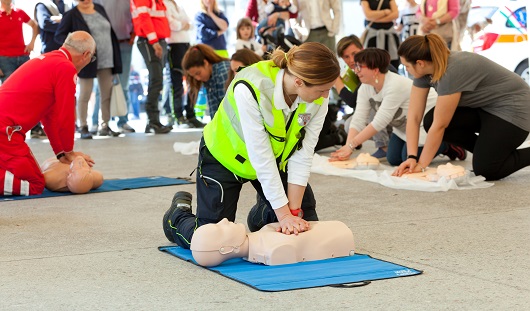AHA BLS Certification
What is included in AHA BLS certification?
Basic first aid and CPR knowledge are invaluable because it allows you to comfort and help someone who is injured until some medical help arrives. You never have an idea when an emergency will arise and who will be affected. Therefore, theAHA trainingcourse is structured for medical professionals and other employees who need to know how to perform CPR and other basic cardiovascular life support skills in a wide variety of environment.This course includes:

- High-quality CPR modules for adults, children, and infants
- The AHA Chain of Survival, respective to the BLS components.
- Early use of an AED
- Effective ventilation using a barrier device
- Importance of teams in multi-user resuscitation and performance as an effective team member during multi-user CPR
- Relief of foreign-body airway obstruction for adults and infants
Why is it important?
The importance of being able to tackle an emergency situation is hard to overestimate, but the major benefits are:
- Knowledge of life saving techniques gives you the ability to help in a variety of emergency situations. You can help improvise victim comfort, prevent death, and use tools to prevent the situation from becoming worse.
- Boosts confidence and willingness to respond in an emergency situation because you have learned the skills and abilities to practice life saving methods in a relaxed environment.
- Encourages a healthier lifestyle because you have a better understanding of the consequences of certain risks and thus, are less likely to become injured.
When is it required?
The AHA training recommends that health care providers use conventional CPR with a combination of breaths and compression. Conventional CPR should also be utilized for all infants (up to age 1) and Children (up to puberty). BLS techniques are applied if any of the persons indicated the following:
- Cardiac arrest
Cardiac arrest occurs when the heart stops pumping in a usual rhythm. In this situation, early defibrillation is the key to returning the victim's heart back to a usual rhythm. When a defibrillator is not available handily, a rescuer or bystander must keep the blood flowing by performing chest compression and rescue breaths. - Respiratory Arrest
Respiratory arrest is when there is no measured breathing for a victim. It tends to occur in addition to a cardiac arrest, but this is not always the case. Respiratory arrest is the most common denotation of BLS in infants and toddlers. The most crucial factor in restoring breathing in the victim is to render quality rescue breaths. - Drowning
In cases of drowning, rescuers should practice CPR techniques as soon as an unresponsive victim is removed from the water. - Choking
Choking occurs when a foreign body blocks the trachea. Rescuers should only step-in in victims who show signs of severe airway obstruction like a-- silent cough, cyanosis, or inability to speak or breathe properly.

